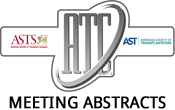2021 American Transplant Congress
Extracellular Vesicles from Patients with Diabetic Nephropathy Induce Endothelial Dysfunction Through Icam-1 and Vcam-1 in an In Vitro Model
*Purpose: Extracellular Vesicles (EVs) are membranous structures produced by cells which contain different cytoplasmic compounds and that have been described as potentially pathogenic elements in…2021 American Transplant Congress
HLA I Antibody-Activated Endothelium Polarized M2-Like Macrophages with Increased Efferocytic and Phagocytic Capacity
*Purpose: The role of intragraft macrophages (Mϕs) during antibody-mediated rejection (AMR) remains unclear. Anti-HLA Abs during AMR drives vascular inflammation as seen by monocyte recruitment…2021 American Transplant Congress
IFNγ, and to a Lesser Extent TNFα, Elicits Protracted Endothelial Cell Expression of Costimulatory Molecules and Antigen Presentation Machinery
Pathology and Laboratory Medicine, UCLA, Los Angeles, CA
*Purpose: Beyond simply “recruiting” leukocytes to sites of injury, local stimulation by the donor vascular compartment may prolong alloimmune responses. Moreover, the dynamics of endothelial…2021 American Transplant Congress
Engineered Human Glomerular Endothelial Cells to Identify Non-hla Antibodies and Decipher Their Pathogenicity After Kidney Transplantation
*Purpose: In kidney transplantation recipients (KTRs), donor-specific antibodies directed against Human Leucocyte Antigens (HLA-DSA) are thought to drive antibody-mediated rejection (AMR) and poor transplant outcome.…2021 American Transplant Congress
Treg Lymphotoxin Engages Lymphotoxin Receptor on Cancer and Endothelial Cells to Promote Cancer Metastatic Migration: Mechanisms for Treg-Cancer Interactions
*Purpose: Treg immune suppression which is critical for transplant graft survival may also enhance tumor growth and metastases. Treg lymphotoxin (LTα1β2) may directly engage the…2021 American Transplant Congress
Treg Engagement of Lymphotoxin Beta Receptor in Lymphatic Endothelial Cells is Required for Allograft Protection
1U Maryland, Baltimore, MD, 2Harvard U, Boston, MA
*Purpose: Sequential migration of regulatory T cells (Treg) from graft to afferent lymphatics and lymph nodes (LN) is needed for Treg suppressive function. Migration requires…2021 American Transplant Congress
CD80/PD-L1 Uniquely Regulates CD4 Effector T Cell Migration
1U Maryland, baltimore, MD, 2U Minnesota, Minneapolis, MN, 3Harvard U, boston, MA
*Purpose: CD80 is a costimulatory molecule expressed on antigen presenting cells (APCs) that binds CD28 and CTLA4, stimulating or inhibiting immunity, respectively. CD80 also binds…2021 American Transplant Congress
Association Between HLA Class II and TLR4 Regulates HLA-II Stimulated P-selectin Expression and Monocyte Capture to Endothelial Cells
Pathology and Laboratory Medicine, University of California Los Angeles, Los Angeles, CA
*Purpose: Antibody-mediated rejection (AMR) is a major obstacle for long-term allograft survival. Donor specific HLA antibodies (DSA) contribute to the process of AMR by binding…2021 American Transplant Congress
Caspase-3 is a Predominant Regulator of Microvascular Dysfunction and Aki-ckd Transition Post Renal Ischemia-reperfusion Injury
CRCHUM, University of Montreal, Montreal, QC, Canada
*Purpose: Ischemia-reperfusion injury (IRI) is a major risk factor for chronic renal failure. Caspase-3, an effector responsible for apoptosis execution, is activated within tubular epithelial…2021 American Transplant Congress
Resolution of Endothelial Inflammation is Delayed Following IFNγ, Which Provokes a Long-lasting Pro-adhesive Phenotype Dependent on JAK/STAT Signaling
Pathology and Laboratory Medicine, UCLA, Los Angeles, CA
*Purpose: Although many cytokines are upregulated within allografts undergoing rejection, intragraft transcripts are dominated by IFN-response signatures. Resolution is a key phase of inflammation needed…
- « Previous Page
- 1
- 2
- 3
- 4
- 5
- 6
- …
- 18
- Next Page »
